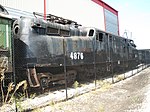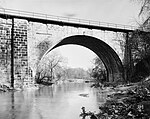Carrollton Ridge, Baltimore

Carrollton Ridge is a neighborhood of South Baltimore, Maryland, United States The area currently known as Carrollton Ridge is a low income residential neighborhood directly west of Baltimore's Inner Harbor. Its boundaries are roughly defined by Frederick Avenue to the north, Carroll Park to the south, Bentalou Street to the west and Fulton Avenue to the east. The neighborhood is racially diverse, though predominantly African American. The homes in Carrollton Ridge are mostly rowhouses. Carrollton Ridge derived its name from two things. First, Dr. Charles Carroll, and his estate (a 117-acre (0.47 km2) remnant of which currently exists as Carroll Park). Second, the geographic ridge which runs alongside the western edge of the neighborhood. Carrollton Ridge is home to Ohio Ave., which at approximately 25 feet long has exactly one residential address, making it the world's shortest residential street according to the Guinness Book of World Records.
Excerpt from the Wikipedia article Carrollton Ridge, Baltimore (License: CC BY-SA 3.0, Authors, Images).Carrollton Ridge, Baltimore
South Pulaski Street, Baltimore Sowebo
Geographical coordinates (GPS) Address Nearby Places Show on map
Geographical coordinates (GPS)
| Latitude | Longitude |
|---|---|
| N 39.283333333333 ° | E -76.649444444444 ° |
Address
South Pulaski Street 323
21223 Baltimore, Sowebo
Maryland, United States
Open on Google Maps







